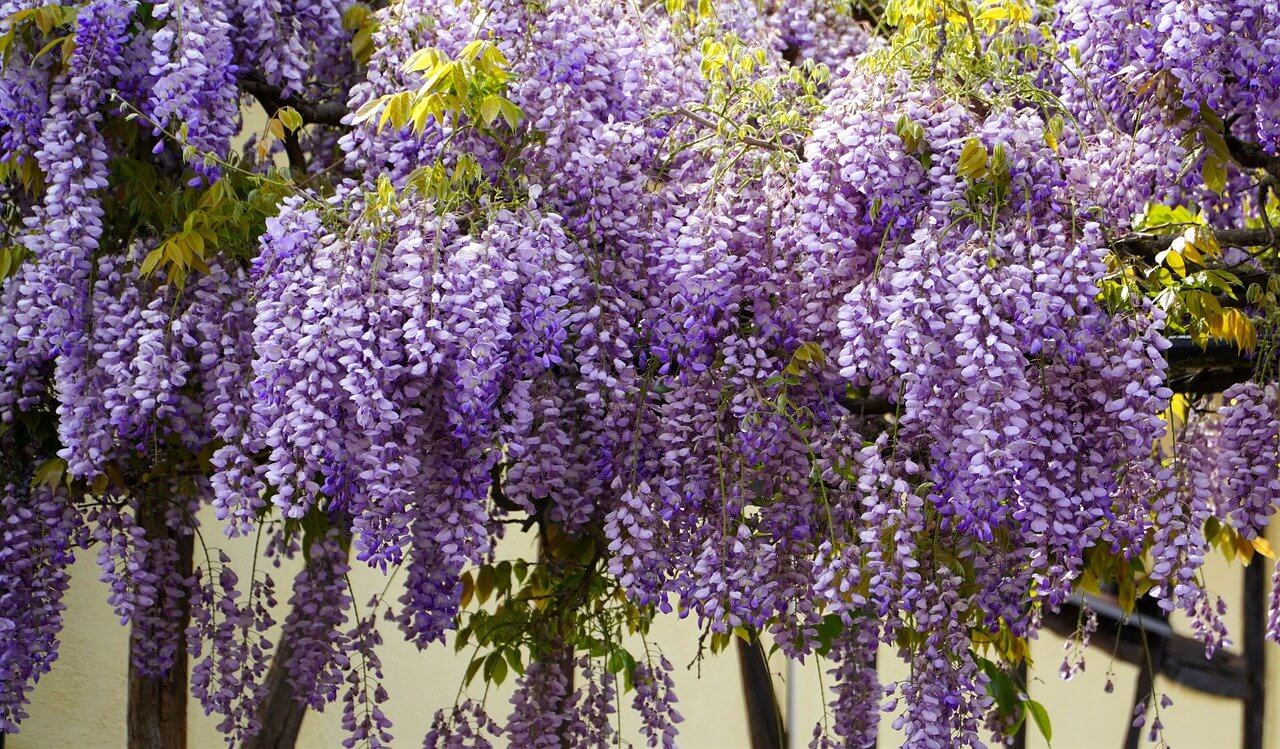Wisteria is a flowering vine that produces stunning blooms throughout any structure it’s allowed to climb. If you’re new to this plant, you might not realize that it can be downright invasive if it’s not kept under control. Pruning is essential to manage your wisteria’s growth and prevent it from damaging your home. In this article, we’ll discuss when and how to trim this beautiful vine.
What You'll Learn Today
When To Prune Wisteria?

Pruning your wisteria at specific, regular times throughout the year will make the task easier on both you and your plant. Experts recommend that you prune wisteria at least twice per year – once in the summer, and once in the winter.
In the summer, pruning should be done as soon as its spring blooms fade. This can happen anytime from early to mid-summer. Although you can wait until later in the summer to trim, if you prune earlier you may be rewarded with a second bloom.
Summer pruning is important to keep the new growth close to the main vine. Flowers bloom on growth from the previous year, so trimming it ensures that the new flowers will be visible.
After summer maintenance, your wisteria will likely continue to grow vigorously for the remainder of the growing season. Another pruning should be done late in the winter to maintain a reasonable size and shape, and allow the plant to put its energy toward new flowers.
How To Trim Wisteria?

The pruning process is a little different in each season. First, let’s talk about what to do in the summer:
Summer Pruning Step 1: Use Sharp Pruners
Make sure your garden shears are sharp and clean before you get to work. This will prevent jagged cuts, which invite infection, and bacteria from entering your wisteria.
2: Remove Suckers
Suckers are small shoots that your plant sometimes produces from its roots. Those should be removed so that your wisteria focuses on growing healthy foliage and flowers instead.
Many gardeners just cut the suckers off near the base of the shoot. You can also dig underneath the suckers to see if they have their own root system. If so, you can remove them and dispose of the young shoots, or transplant and grow them elsewhere.
Step 3: Trim Any Spent Shoots
After the flowers have died off of your wisteria, you’ll be left with long, empty shoots. You can trim those back, along with any new growth to about 6 inches in length. Try to leave about 3-5 buds on each branch you trim.
When you’re trimming, make the cut just above a bud. Any stems that are left behind above a bud will die off anyway.
Step 4: Prune Unneeded Shoots
This step is optional, depending on how you want your wisteria to look. If you’re trying to maintain a certain shape or growth pattern, simply remove any shoots that are growing out of form or make the plant look unruly.
Winter pruning is essentially a repeat of what you did in the summer, to manage whatever grew during the remainder of the growing season. This should be easier to complete since the leaves will have all fallen off.
Winter Pruning Step 1: Trim The Lateral Branches
Cut back any of the secondary branches, including the ones that you trimmed in the summer, back to 3-5 buds. This helps to keep the plant looking tidy and ensures that new flowers will take center stage in the spring.
Step 2: Tidy Up
Again, prune any branches that are growing out of place to achieve your ideal wisteria shape. With no leaves in the way, you’ll be able to clearly see the main framework of the vine.
This YouTube gardener gives a great demonstration of how to prune wisteria in summer, showing viewers exactly where to make your cuts:
Can Wisteria Be Cut Back Hard?
If your wisteria is old or severely overgrown, you may have to do some hard pruning to get it under control. Hard pruning includes drastically cutting back long branches of wisteria and removing large sections of stem.
In some cases, while hard pruning wisteria it may be best to trim the vine down all the way to one of the main branches or even to the ground. The amount that you cut it back depends on the level of overgrowth and your vision for the vine.
Although it’s best not to let it get to the point where hard pruning is necessary, wisteria is hardy and can withstand the stress. It’s understandable to be worried about making drastic cuts, but doing so encourages strong new branches and blooms to form.
How To Prune Overgrown Wisteria
Since wisteria can get out of hand fairly quickly, you’ll likely have to deal with some overgrowth at some point. Although not much different from the normal pruning process, here’s a general plan of attack:
- First, tackle the dying and dead branches by cutting them all the way down to the nearest healthy growth.
- Cut back all of the suckers growing from the base of the plant. You should be left with only one or two main trunks when you’re done.
- Prune any of the lateral branches that are growing too close together or seem out of form.
- If the length of the vine is too tall, you can trim the top of the main trunk to the desired height.
- Once you’ve gotten the wisteria back under control, be sure to keep up with regular prunings at least twice per year.
When wisteria is neglected for too long, it can do some serious damage to the structure that it has been allowed to climb – including your home. With fast, strong growth each season, it can get really heavy. As long as you keep up with the maintenance, owning your wisteria will be a treat, rather than a headache.
Will my Wisteria come back from a hard pruning?
This plant is incredibly hardy and vigorous. You will find that it bounces straight back from being pruned hard, even if you take it right back to the main trunk. It may not come back until the following year, but it will definitely be back!